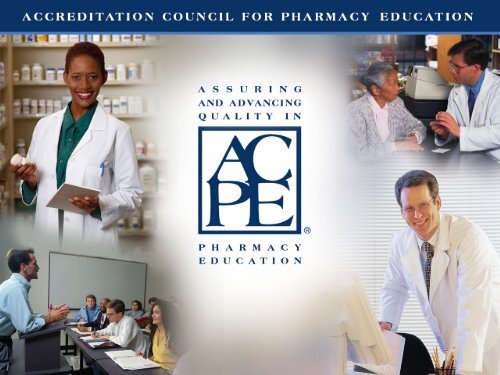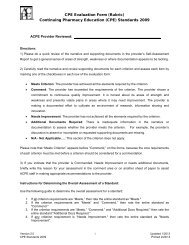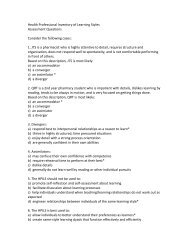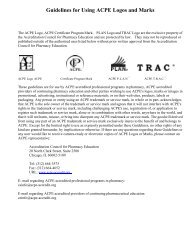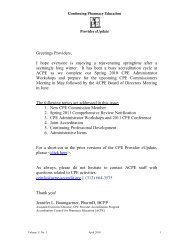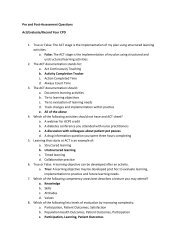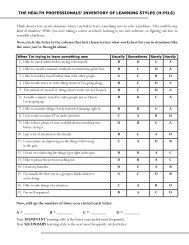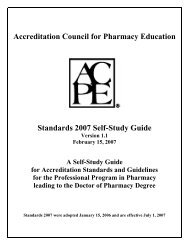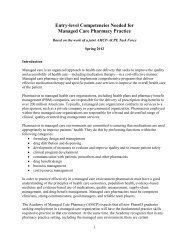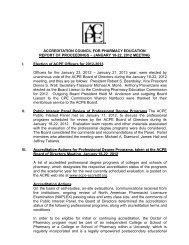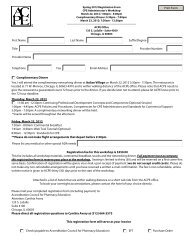2011 ACPE Update - Accreditation Council for Pharmacy Education
2011 ACPE Update - Accreditation Council for Pharmacy Education
2011 ACPE Update - Accreditation Council for Pharmacy Education
You also want an ePaper? Increase the reach of your titles
YUMPU automatically turns print PDFs into web optimized ePapers that Google loves.
<strong>Accreditation</strong> <strong>Council</strong> <strong>for</strong> <strong>Pharmacy</strong><br />
<strong>Education</strong> (<strong>ACPE</strong>) <strong>Update</strong><br />
Peter H. Vlasses, PharmD, DSc (Hon), BCPS, FCCP<br />
Executive Director<br />
Dimitra V. Travlos, PharmD, BCPS<br />
Assistant Executive Director and<br />
Director, CPE Provider <strong>Accreditation</strong> Program<br />
ASHP Midyear Clinical Meeting ▪ New Orleans, Louisiana<br />
December 5, <strong>2011</strong>
<strong>ACPE</strong> History<br />
• Founded in 1932 <strong>for</strong> accreditation of<br />
professional degree programs by:<br />
– National Association of Boards of <strong>Pharmacy</strong><br />
(NABP) (regulators)<br />
– American Association of Colleges of <strong>Pharmacy</strong><br />
(AACP) (educators)<br />
– American Pharmacists Association (APhA)<br />
(practitioners)
<strong>ACPE</strong> History<br />
• <strong>Accreditation</strong> of CE Providers added in 1975<br />
• <strong>Accreditation</strong> of Certificate Programs<br />
(1999 – 2008)<br />
• International Services Program added in <strong>2011</strong><br />
• <strong>ACPE</strong> is an autonomous, independent, not<strong>for</strong>-profit<br />
agency with headquarters in<br />
Chicago, IL<br />
• New address: 135 S. LaSalle St., Suite 4100,<br />
Chicago, IL 60603
<strong>ACPE</strong> Board of Directors<br />
• Heidi M. Anderson, PhD<br />
(AACP, 2006–2012)<br />
(President)<br />
• Robert Beardsley, RPh, PhD<br />
(AACP, 2008–2014)<br />
(Vice President)<br />
• Michael A. Moné, RPh, JD<br />
(NABP, 2006–2012)<br />
(Secretary/Treasurer)<br />
• Barbara G. Burch, MS, EdD<br />
(ACE, 2010–2016)<br />
• Bruce Canaday, PharmD<br />
(APhA, 2010–2016)<br />
• Stephanie F. Gardner, PharmD, EdD<br />
(AACP, 2010–2016)<br />
• Dennis K. McAllister, RPh<br />
(NABP, 2010–2016)<br />
• Warren A. Narducci, PharmD<br />
(APhA, 2006–2012)<br />
• Anthony Provenzano, PharmD<br />
(APhA, <strong>2011</strong>–2014)<br />
• Donna S. Wall, PharmD<br />
(NABP, 2008–2014)
New Appointees –<br />
<strong>ACPE</strong> Board of Directors<br />
• Michael A. Moné, RPh, JD<br />
(reappointed by NABP, 2012–2018)<br />
• Victoria F. Roche, PhD<br />
(appointed by AACP, 2012–2018)<br />
• Timothy L. Tucker, PharmD<br />
(appointed by APhA, 2012–2018)
<strong>ACPE</strong> Executive Staff Members<br />
• Peter H. Vlasses, PharmD, BCPS<br />
Executive Director<br />
• Jeffrey W. Wadelin, PhD<br />
Assoc. Exec. Director and<br />
Director, Professional Degree<br />
Program <strong>Accreditation</strong><br />
• Dimitra Travlos, PharmD, BCPS<br />
Assistant Exec. Director, and<br />
Director, CPE Provider<br />
<strong>Accreditation</strong><br />
• Michael J. Rouse, BPharm<br />
(Hons), MPS<br />
Assistant Exec. Director,<br />
Professional Affairs and Director,<br />
International Services<br />
• J. Gregory Boyer, PhD<br />
Assistant Exec. Director and Assistant<br />
Director, Prof. Degree Program<br />
<strong>Accreditation</strong><br />
• Jennifer Baumgartner, PharmD, BCPP<br />
Assistant Director, Continuing<br />
<strong>Pharmacy</strong> <strong>Education</strong> Provider<br />
<strong>Accreditation</strong><br />
• Sharon L. Hudson<br />
Assistant Exec. Director, and Director,<br />
Operations and Human Resources
Discussion Overview<br />
• 2012 <strong>ACPE</strong> Stakeholder Conference<br />
• PharmD Program <strong>Accreditation</strong> <strong>Update</strong>s<br />
• CPE <strong>Update</strong>s<br />
• International Services Program<br />
• Issues of Quality, Quantity, and Expansion<br />
• Quality and Capacity in Experiential<br />
<strong>Education</strong>
<strong>ACPE</strong> ACTIVITIES UPDATE
S2007 Guidelines 2.0<br />
• Guidelines 2.0 are in effect<br />
– Changes posted on www.acpe-accredit.org<br />
– Site teams began evaluations in Fall <strong>2011</strong> cycle<br />
– Reflects <strong>ACPE</strong> Board of Directors policy<br />
decisions<br />
– 15 new “must” statements (many have<br />
previously been communicated)<br />
• Rubric v4.0 became effective July 1<br />
– Assessment & <strong>Accreditation</strong> Management<br />
System (AAMS) is updated with Rubric v4.0
S2007 Guidelines 2.0 Highlights<br />
• Added emphasis on:<br />
– Interprofessional education, service and research<br />
– Teaching methods to enhance learning<br />
– Fostering of post-graduate educational opportunities (i.e.,<br />
residencies, fellowships)<br />
– Simulation as a component of IPPEs<br />
– Mission driven program per<strong>for</strong>mance assessment<br />
– Student learning outcomes<br />
– Faculty scholarship and research<br />
• Integration of:<br />
– ASHP-<strong>ACPE</strong> Task Force on Entry-level Competencies<br />
– Pre-APPE Core Per<strong>for</strong>mance Domains/Abilities
Extension of Time Between Self-Studies<br />
• Beginning in January 2012, the time between selfstudies<br />
<strong>for</strong> comprehensive reviews of established<br />
programs shifts to eight-year intervals<br />
• <strong>ACPE</strong> will continue processes <strong>for</strong> interim<br />
monitoring of programs using data provided<br />
through AAMS and NABP and substantive<br />
change reporting by programs<br />
• <strong>ACPE</strong>’s review process <strong>for</strong> new colleges and<br />
schools will remain unchanged
<strong>ACPE</strong> Stakeholder Conference<br />
September 12–14, 2012<br />
Atlanta, GA<br />
• Advancing Quality in <strong>Pharmacy</strong> <strong>Education</strong>:<br />
Charting <strong>Accreditation</strong>’s Future<br />
• Invitational consensus-seeking conference<br />
• In collaboration with a broad array of<br />
leaders in pharmacy, health care, and<br />
education
<strong>ACPE</strong> Stakeholder Conference<br />
Objectives<br />
• Examine competencies that are currently<br />
required of pharmacists and competencies<br />
that will be required in the future<br />
• Expand evidence-based practices in<br />
assessing the quality of educational<br />
programs<br />
• In<strong>for</strong>m standards, guidelines, and process<br />
quality improvement initiatives
<strong>ACPE</strong> Stakeholder Conference<br />
Invitees (n= +/-100)<br />
• <strong>ACPE</strong> Sponsors: APhA, AACP, NABP<br />
• JCPP and CCP member organizations<br />
• Deans and faculty with various expertise<br />
• Practitioners and regulators<br />
• <strong>ACPE</strong> Public Interest Panel members<br />
• Members of other health professions<br />
• Non-pharmacy academic experts
<strong>ACPE</strong> CPE UPDATE
Issues and <strong>Update</strong>s in CPE<br />
• CPE Commission<br />
• CPE Monitor<br />
• Joint <strong>Accreditation</strong><br />
• Evolution to CPD
CPE Commission <strong>2011</strong><br />
• Mary-Anne Benedict, MSN, RN (VA New England Health Care System)<br />
• Stephen Caiola, MS (University of North Carolina at Chapel Hill School of<br />
<strong>Pharmacy</strong>)<br />
• Janet Cline, RPh (Creative <strong>Education</strong>al Concepts, Inc.)<br />
• Jeannine Dickerhofe, RPh (Kaiser Foundation Health Plan of Colorado<br />
Department of <strong>Pharmacy</strong>)<br />
• Kristin Janke, PhD (University of Minnesota College of <strong>Pharmacy</strong>)<br />
• John Kirtley, PharmD (Arkansas State Board of <strong>Pharmacy</strong>)<br />
• Scott Meyers, RPh, MS, FASHP (Illinois <strong>Council</strong> of Health-System<br />
Pharmacists) (Chair)<br />
• Jennifer Moulton, RPh (Collaborative <strong>Education</strong> Institute) (Vice Chair)<br />
• Timothy Welty, PharmD, FCCP, BCPS (University of Kansas School of<br />
<strong>Pharmacy</strong>)<br />
• Carol Abel (Food Marketing Institute)<br />
• Warren Narducci, PharmD (<strong>ACPE</strong> Board Liaison)
What is CPE Monitor?<br />
A national, e-system currently under collaborative<br />
development by NABP and <strong>ACPE</strong> to store and<br />
authenticate data <strong>for</strong> completed CPE units <strong>for</strong> both<br />
pharmacists and pharmacy technicians<br />
• Provides a central repository <strong>for</strong> CPE in<strong>for</strong>mation<br />
• Enables efficient verification of completion of CPE<br />
by State Boards of <strong>Pharmacy</strong><br />
• Designed to streamline the collection and reporting<br />
of continuing pharmacy education <strong>for</strong> pharmacists<br />
and technicians.
Essential Elements of<br />
the System<br />
• Pharmacist /technician obtains NABP eProfile ID<br />
• Provider collection of identifying in<strong>for</strong>mation and<br />
transmission of identifying in<strong>for</strong>mation and<br />
participation in<strong>for</strong>mation to <strong>ACPE</strong><br />
• <strong>ACPE</strong> validation of identity and processing of<br />
in<strong>for</strong>mation and electronically <strong>for</strong>warding to NABP<br />
• NABP uploads in<strong>for</strong>mation to individual profiles<br />
• Access to in<strong>for</strong>mation by pharmacists, technicians,<br />
and state boards of pharmacy
Obtaining an eProfile ID<br />
• Over 94,000 pharmacists and 31,000<br />
pharmacy technicians have obtained<br />
eProfile IDs from NABP<br />
• To create eProfile ID<br />
– Go to: www.mycpemonitor.net<br />
– Secure registration <strong>for</strong>m<br />
• Encrypted <strong>for</strong> applicant protection<br />
and security
CPE Monitor Page
NABP Data<br />
Security Practices<br />
• Encrypted data collection pages<br />
• Encrypted in<strong>for</strong>mation in databases<br />
• Limits to in<strong>for</strong>mation by staff<br />
• Criminal background checks on all staff with access to<br />
sensitive in<strong>for</strong>mation<br />
• Firewalls, electronic intrusion prevention and detection<br />
systems<br />
• Data movement monitoring and restrictions on certain<br />
types of data movements within and outside of NABP<br />
systems<br />
• External audits of system security and effectiveness
Timeline<br />
• March 10, <strong>2011</strong>: Pharmacists and pharmacy<br />
technicians can start to complete their e-profile at:<br />
www.MyCPEMonitor.net<br />
• Following registration an e-mail will be sent with NABP e-ID<br />
• Beginning March <strong>2011</strong><br />
• Providers will transitioning their systems to accommodate<br />
the additional two fields (NABP e-ID, MMDD)<br />
• <strong>ACPE</strong> will pilot the program<br />
• 2012: System implemented by all providers*<br />
• All pharmacists must be registered to receive CPE credit<br />
* Timeline established based on the pilot program; full<br />
implementation deadline no later than December 31, 2012
Questions on CPE Monitor<br />
• Pharmacists and pharmacy technicians call<br />
NABP Customer Service at 847-391-4406<br />
– For questions related to NABP e-Profile creation and<br />
maintenance; reporting process to boards of<br />
pharmacy<br />
– Hours: Monday-Friday, 8:30AM – 5PM CT<br />
• CPE providers contact <strong>ACPE</strong> either by email at<br />
cpemonitor@acpe-accredit.org or phone: 312-<br />
664-3575<br />
– For questions related to provider participation and<br />
procedures<br />
– Hours: Monday-Friday 9:00AM – 4:30PM CT
A Continuing Professional Development Cycle<br />
Previously “ACT”
CPD: Bridging the Classroom and the<br />
Workplace<br />
“The new vision <strong>for</strong> continuing education will be based on an approach<br />
called continuing professional development (CPD), in which learning takes<br />
place over a lifetime and stretches beyond the classroom to the point of<br />
care.” Institute of Medicine, December 2009
CPD: Bridging the Classroom and<br />
the Workplace<br />
or “ACT”
<strong>ACPE</strong> CPD Task<strong>for</strong>ce<br />
• Survey of members and staff of state boards<br />
• Presentations to state boards of pharmacy<br />
• Resources on <strong>ACPE</strong> website<br />
• <strong>Education</strong>al programming at national, state,<br />
AACP/NABP district meetings<br />
• Publications<br />
• Tracking developments and initiatives at<br />
state level
<strong>2011</strong> Survey of Members and Staff of<br />
State Boards of <strong>Pharmacy</strong><br />
• Administered August/September <strong>2011</strong><br />
• To gather input to help in<strong>for</strong>m future <strong>ACPE</strong><br />
initiatives and direction <strong>for</strong> models that<br />
support lifelong learning of pharmacists and<br />
pharmacy technicians<br />
• Responses from individuals from 29/53<br />
states and territories (55%)<br />
• Requesting remaining states to respond
Joint <strong>Accreditation</strong> <strong>for</strong> the Provider of Continuing<br />
<strong>Education</strong> <strong>for</strong> the Healthcare Team<br />
<strong>Accreditation</strong> <strong>Council</strong> <strong>for</strong><br />
Continuing Medical<br />
<strong>Education</strong><br />
(ACCME)<br />
American Nurses<br />
Credentialing Center<br />
(ANCC)<br />
<strong>Accreditation</strong> <strong>Council</strong> <strong>for</strong><br />
<strong>Pharmacy</strong> <strong>Education</strong><br />
(<strong>ACPE</strong>)
“CE Developed by the Team<br />
<strong>for</strong> the Team”<br />
• Support healthcare team-focused education that<br />
improves patient care<br />
• Simplifies the application process <strong>for</strong> CE providers<br />
seeking accreditation by two or more of the<br />
organizations<br />
• The Joint <strong>Accreditation</strong> Process:<br />
– Decreases the provider’s workload<br />
– Increases the number of continuing education activities<br />
with an interprofessional audience<br />
– Increases communication among accreditation agencies<br />
from different health care disciplines to exchange and<br />
share ideas
Joint <strong>Accreditation</strong> Eligibility<br />
• The organization is already accredited in good<br />
standing by at least two of the three national<br />
accrediting bodies (ANCC, <strong>ACPE</strong>, and/or ACCME)<br />
• One national accrediting body (ACCME, <strong>ACPE</strong> or<br />
ANCC) and one state accrediting body (ACCME-<br />
Recognized Accreditor or ANCC-Accredited Approver)<br />
• 25% of the educational activities delivered by the<br />
organization during the past 12 months is comprised<br />
of education designed by and <strong>for</strong> the healthcare team<br />
• The organization engages in the joint accreditation<br />
process and demonstrates compliance with the<br />
compliance criteria and policies
Providers with Joint <strong>Accreditation</strong><br />
• Cine-Med, Inc.<br />
as of December <strong>2011</strong><br />
• Creighton University<br />
• Institute <strong>for</strong> Healthcare Improvement<br />
• North American Center <strong>for</strong> Continuing<br />
Medical <strong>Education</strong><br />
• VHA, Inc.
<strong>ACPE</strong> INTERNATIONAL SERVICES<br />
PROGRAM (ISP)
<strong>ACPE</strong> International Services<br />
Program<br />
• Established January <strong>2011</strong><br />
• Assists international pharmacy stakeholders<br />
– Program Certification<br />
– Consultation<br />
– Workshops and Training Programs<br />
– Long-Term Projects<br />
• Oversight by International Commission
ISP Mission<br />
Promote, assure, and advance the<br />
quality of pharmacy education<br />
internationally to improve patient care<br />
through safe and effective medication<br />
use
International Commission<br />
Members<br />
• William A. Gouveia, Chair, MS, FASHP, Belmont,<br />
Massachusetts, USA<br />
• George R. Spratto, Vice Chair, PhD, Ox<strong>for</strong>d, Connecticut,<br />
USA<br />
• Robert S. Beardsley, RPh, PhD, Baltimore, Maryland, USA<br />
• Bruce Canaday, PharmD, Philadelphia, Pennsylvania, USA<br />
• Peter J. Kielgast, MSc (Pharm), DSc (Hon), Copenhagen,<br />
Denmark<br />
• Claude Mailhot, BPharm, DPH, PharmD, Montreal, Canada
International Services Program<br />
Advisory Group (ISPAG)<br />
• Members from 15 countries have been selected to<br />
provide broad geographic and cultural diversity<br />
• ISPAG will function as an in<strong>for</strong>mal group to provide<br />
feedback, ideas, and recommendations to the <strong>ACPE</strong><br />
Board via the International Commission<br />
• Some individual members may also contribute practically<br />
to initiatives, activities, and projects in their areas of<br />
interest and expertise
Systems <strong>for</strong> Improved Access to<br />
Pharmaceuticals and Services (SIAPS)<br />
• Five-year initiative in partnership with Management<br />
Sciences <strong>for</strong> Health (MSH)<br />
– Other core partners: Harvard School of Public Health,<br />
Harvard Pilgrim Health Care Institute, Logistics<br />
Management Institute, and the University of Washington<br />
Department of Global Health<br />
• Funded by a grant from the U.S. Agency <strong>for</strong><br />
International Development (USAID)<br />
• <strong>ACPE</strong> will engage in assessing pharmacy<br />
education and training in a number of developing<br />
countries
<strong>ACPE</strong> Responsibilities in SIAPS Program<br />
• Evaluate pharmacy education in selected developing countries <strong>for</strong><br />
both pre-service education and in-service training<br />
• Assess the degree to which academic and training institutions have<br />
incorporated the principles of pharmaceutical management<br />
• Establish a framework and strategic approach <strong>for</strong> QA of pharmacy<br />
training and education<br />
• Develop models to establish or strengthen <strong>for</strong>malized bodies of<br />
accreditation <strong>for</strong> pharmacy education and training in the selected<br />
countries<br />
• Assess the quality of pharmacy education and training to support<br />
pharmaceutical services delivery in the selected countries.
QUESTIONS AND/OR DISCUSSION
ISSUES AT THE INTERSECTION OF<br />
QUALITY AND QUANTITY
Accredited PharmD Programs*<br />
Programs with <strong>Accreditation</strong> Status (n = 125)<br />
• Full <strong>Accreditation</strong> Status: 103<br />
– Programs that have graduated students<br />
• Candidate <strong>Accreditation</strong> Status: 17<br />
– Programs with students enrolled but have not yet produced graduates or<br />
have graduates and have not addressed all the accreditation standards<br />
• Pre-Candidate <strong>Accreditation</strong> Status: 5<br />
– Programs that have not yet enrolled students or are in their first year of<br />
classes<br />
* Inclusive of June <strong>2011</strong> Board Actions
Distance Campus Expansions<br />
• 26 programs have distance campuses*<br />
– 19 are public and 7 are private<br />
• 3 programs are in the process of being<br />
evaluated to open a distance campus<br />
• 5 programs have branch/distance campuses<br />
out of state<br />
(* Distance campus = delivery of didactic curriculum to/from site)
<strong>Pharmacy</strong> School Graduation Trends<br />
14000<br />
13,822<br />
Number of Graduates<br />
12000<br />
10000<br />
8000<br />
6000<br />
4000<br />
2000<br />
0<br />
6,956<br />
11,487<br />
<strong>Pharmacy</strong> school graduates <strong>2011</strong>–2014<br />
projected based on current enrollment<br />
and <strong>ACPE</strong>-estimated attrition<br />
Source: AACP Fall 2010 Data and <strong>ACPE</strong> February <strong>2011</strong> Estimates
Are new colleges and schools of<br />
pharmacy primarily responsible <strong>for</strong><br />
this increase in pharmacy<br />
graduates since 2003?
Increase in <strong>Pharmacy</strong> Graduates Since 2003<br />
Source: AACP Fall 2010 Data and <strong>ACPE</strong> February <strong>2011</strong> Estimates<br />
Increase in No. of Graduates<br />
(from 2003 baseline)<br />
7000<br />
6000<br />
5000<br />
4000<br />
3000<br />
2000<br />
1000<br />
Increase attributable to pre-1995 schools<br />
Increase attributable to post-1995 schools<br />
n = 98<br />
n = total number of US colleges and<br />
n = 93<br />
schools with graduates<br />
n = 90<br />
n = 89<br />
n = 88<br />
n = 85<br />
n = 83<br />
n = 102<br />
n = 110<br />
n = 114<br />
n = 118<br />
0<br />
2004 2005 2006 2007 2008 2009 2010 <strong>2011</strong> 2012 2013 2014<br />
(Actual numbers)<br />
(Projected numbers)
Increase in <strong>Pharmacy</strong> Graduates Since 2003<br />
Source: AACP Fall 2010 Data and <strong>ACPE</strong> February <strong>2011</strong> Estimates<br />
Increase in No. of Graduates<br />
(from 2003 baseline)<br />
7000<br />
6000<br />
5000<br />
4000<br />
3000<br />
2000<br />
1000<br />
Increase attributable to pre-1995 schools<br />
Increase attributable to post-1995 schools<br />
n = 98<br />
n = total number of US colleges and<br />
n = 93<br />
schools with graduates<br />
n = 90<br />
n = 89<br />
n = 88<br />
n = 85<br />
n = 83<br />
n = 102<br />
n = 110<br />
n = 114<br />
n = 118<br />
0<br />
2004 2005 2006 2007 2008 2009 2010 <strong>2011</strong> 2012 2013 2014<br />
(Actual numbers)<br />
(Projected numbers)
Can <strong>ACPE</strong> intervene to stop the<br />
rapid expansion of pharmacy<br />
schools in the U.S.?
Manpower Issues Cannot Be<br />
Considered in <strong>Accreditation</strong><br />
• <strong>Accreditation</strong> is designed to advance<br />
quality – not restrict the market<br />
• Sherman Antitrust Act of 1890 prohibits<br />
restraint of competition<br />
• PharmD is a nationally recruited applicant<br />
pool with national employment<br />
opportunities
<strong>Accreditation</strong> and Competition<br />
• <strong>Accreditation</strong> decisions may affect the<br />
marketplace<br />
• <strong>Accreditation</strong> decisions are based strictly on<br />
compliance with the standards<br />
– Cannot consider the effect on the marketplace<br />
• Consideration of the effect on the marketplace<br />
in making accreditation decisions could subject<br />
<strong>ACPE</strong> to prosecution under antitrust laws and,<br />
potentially, jeopardize <strong>ACPE</strong>’s recognition by<br />
the U.S. DOE
Do the accrediting bodies <strong>for</strong> other<br />
health professions dictate the<br />
quantity of schools or numbers of<br />
graduates?
Growth Trends in <strong>Education</strong><br />
Among Other Health Professions<br />
Health Profession/<br />
Accreditor<br />
Accredited Programs<br />
2000<br />
Accredited Programs<br />
Plus Applications<br />
(Net % Change)<br />
<strong>2011</strong><br />
Medicine (LCME) 125 141 (+13%)<br />
Osteopathy (AOA-COCC) 19 28 (+47%)<br />
Nursing (CCNE) DNP = 0 (new degree) 58<br />
Physical Therapy (APTA) 196 229 (+17%)<br />
Occupational Therapy<br />
(OTA) 131 154 (+18%)<br />
Dentistry (ADA CODA) 55 60 (+9%)
New School Process<br />
Required Evaluations & On-site Visits <strong>for</strong><br />
<strong>ACPE</strong> <strong>Accreditation</strong> of New Programs<br />
Draft Application On-site Consultation (1 staff member)<br />
Paper review of draft application (team of 4)<br />
Evaluation <strong>for</strong> Precandidate Status (team of 4-5)<br />
Evaluation <strong>for</strong> Candidate Status (team of 4-5)<br />
Evaluation <strong>for</strong> Continuation of<br />
Candidate Status (team of 2-3)<br />
Over 7 years: a New Program is evaluated by 24–36 individuals<br />
Consideration of Full Status (team of 4-5)<br />
Evaluation <strong>for</strong> Continuation of Initial Full Status<br />
(team of 2-3)
Precandidate Thresholds<br />
• Programs must meet threshold expectations<br />
<strong>for</strong> 20 distinct elements to qualify <strong>for</strong> an<br />
initial comprehensive on-site evaluation<br />
• Detailed overview of threshold elements<br />
www.acpeaccredit.org/pdf/Threshold_Document.pdf
Precandidate Thresholds<br />
• Mission includes scholarship<br />
• University infrastructure<br />
supports research and<br />
scholarship<br />
• Institution is regionally<br />
accredited<br />
• Institution is authorized to<br />
grant a doctoral degree<br />
• Dean is installed with<br />
sufficient time to develop the<br />
program<br />
• Dean is qualified and has<br />
authority as defined by<br />
standard 8<br />
• Dean has appropriate prior<br />
experience<br />
• Dean has appropriate<br />
research and scholarship<br />
background.<br />
• Full-time faculty leadership<br />
team installed<br />
• Leadership team has<br />
essential skills complementing<br />
those of the Dean
Precandidate Thresholds<br />
• First-year Faculty in Place by<br />
First Team Visit<br />
• Senior Faculty Provide<br />
Mentoring<br />
• Curriculum and Draft Syllabi<br />
Have Been Prepared<br />
• Curricular Map Shows<br />
Sufficient Hours<br />
• Student Services Available<br />
by First Day of Classes<br />
• Physical Facilities Available<br />
on Proposed First Day of<br />
Classes<br />
• Funding Matches Program<br />
Activity<br />
• IPPEs Will Be Ready When<br />
Needed<br />
• APPEs Will Be Ready When<br />
Needed<br />
• No Significant Program<br />
Expansion
All new school applicants are<br />
granted pre-candidate status on<br />
the first attempt.
50% of programs that applied<br />
from 2008 to <strong>2011</strong> were not<br />
authorized <strong>for</strong> an on-site visit on<br />
their initial application attempt.
Precandidate Thresholds<br />
• Some programs authorized <strong>for</strong> a site visit are<br />
not subsequently approved <strong>for</strong> precandidate<br />
status<br />
– Recently 3 programs denied/withdrew<br />
– Accepted students unable to proceed<br />
– Costly and challenging <strong>for</strong> everyone
MEASURES OF CAPACITY AND QUALITY IN<br />
PHARMACY EDUCATION
<strong>ACPE</strong> Monitoring of <strong>Pharmacy</strong><br />
Programs – Quality and Resources<br />
• Comprehensive and focused accreditation reviews<br />
• Annual monitoring metrics (e.g., NAPLEX,<br />
enrollments, progression/graduation, dismissals,<br />
withdrawals, attrition)<br />
• AACP standardized surveys (e.g., graduating<br />
students, faculty, preceptors, and alumni)<br />
• Launch of Assessment and <strong>Accreditation</strong><br />
Management System (AAMS) with AACP<br />
• Identification of noteworthy practices
Passing Rate<br />
NAPLEX Passing Rate <strong>for</strong> First-Time<br />
Candidates 2004–2010<br />
Pre-1995 versus Post-1995 Programs<br />
100%<br />
98%<br />
96%<br />
94%<br />
92%<br />
90%<br />
88%<br />
86%<br />
84%<br />
82%<br />
80%<br />
96.7%<br />
95.8%<br />
7 Post-1995<br />
Programs<br />
92.0%<br />
85.9%<br />
93.0%<br />
92.3%<br />
95.6%<br />
97.0%<br />
96.7%<br />
95.1% 96.3% 96.5%<br />
94.4%<br />
94.1%<br />
2004 2005 2006 2007 2008 2009 2010<br />
24 Post-1995<br />
Programs<br />
Pre-1995<br />
Programs<br />
Post-1995<br />
Programs
Percentage of Programs<br />
60%<br />
50%<br />
40%<br />
30%<br />
20%<br />
10%<br />
0%<br />
2010 NAPLEX Passing Rate Spread <strong>for</strong><br />
Pre-1995 versus Post-1995 Programs<br />
n = 1<br />
n = 3<br />
n = 1<br />
n = 2<br />
n = 6<br />
n = 1<br />
66 -70% 71 - 75% 76 - 80% 81 - 85% 86 - 90% 91 - 95% 96 -<br />
100%<br />
n= 23<br />
n = 12<br />
n= 39<br />
n = 10<br />
Pre-1995<br />
Programs<br />
Post-1995<br />
Programs
2010 Graduating Student Survey Results<br />
Section I: Professional Competencies/Outcomes (N = 7,496)<br />
The The PharmD Program Program prepared prepared me to: me to:<br />
Communicate with patients and caregivers<br />
Communicate with patients and caregivers<br />
54.5%<br />
43.5%<br />
1.7%<br />
Gather and use specific in<strong>for</strong>mation to<br />
Gather<br />
identify<br />
and use<br />
patient<br />
specific in<strong>for</strong>mation<br />
medication-related<br />
to identify patient<br />
medication-related problems problems<br />
54.4%<br />
43.7%<br />
1.6%<br />
Develop a patient care plan to manage<br />
each medication-related problem<br />
Develop a patient care plan to manage each medication-related<br />
problem<br />
Work with a health care team to implement<br />
the patient care plan<br />
Work with a health care team to implement the patient care plan<br />
50.0%<br />
43.4%<br />
47.9%<br />
51.5%<br />
1.9%<br />
4.6%<br />
Strongly Agree<br />
Agree<br />
Disagree/Strongly<br />
Disagree<br />
Manage the system of medication use to<br />
affect patients<br />
Manage the system of medication use to affect patients<br />
37.4%<br />
55.7%<br />
4.4%<br />
Work with other stakeholders and resolve<br />
problems related to medication use<br />
Work with other stakeholders to identify and resolve problems<br />
related to medication use<br />
41.3%<br />
55.0%<br />
3.2%
My introductory pharmacy practice<br />
experiences were valuable in helping to<br />
prepare me <strong>for</strong> my advanced pharmacy<br />
practice experiences<br />
2010 Graduating Student Survey Results<br />
Section III: <strong>Pharmacy</strong> Practice Experiences (N = 7,496)<br />
24.1%<br />
48.5%<br />
21.4%<br />
My introductory pharmacy practice experiences<br />
permitted my involvement in direct patient care<br />
responsibilities in both community and<br />
institutional settings<br />
23.4%<br />
47.5%<br />
22.9%<br />
In the community pharmacy setting, I was<br />
able to apply my patient care skills<br />
42.3%<br />
47.8%<br />
8.7%<br />
Strongly Agree<br />
In the ambulatory care setting, I was able to<br />
apply my patient care skills<br />
54.0%<br />
39.6%<br />
4.1%<br />
Agree<br />
In the hospital or health-system pharmacy<br />
setting, I was able to apply my patient care<br />
skills<br />
43.4%<br />
47.2%<br />
8.3%<br />
Disagree/Strongly<br />
Disagree<br />
In the inpatient/acute care setting, I was able<br />
to apply my patient care skills<br />
48.5%<br />
45.2%<br />
4.4%<br />
Overall, my advanced practice experiences<br />
were valuable in helping me to achieve the<br />
professional competencies<br />
46.9%<br />
48.3%<br />
4.0%
2010 Faculty and Preceptor Survey Curriculum Responses<br />
(Faculty N = 2,604 / Preceptor N = 8,170)<br />
The PharmD Program prepared<br />
students to:<br />
Develop and use patient-specific care<br />
plans<br />
96.3%<br />
97.5%<br />
Efficiently manage a patient-centered<br />
pharmacy practice<br />
93.9%<br />
93.6%<br />
Develop disease management programs<br />
91.1%<br />
89.9%<br />
Preceptor Strongly<br />
Agree/Agree<br />
Manage the system of medication use<br />
Promote the availability of health<br />
promotion and disease prevention<br />
initiatives<br />
94.5%<br />
93.7%<br />
95.4%<br />
94.4%<br />
Faculty Strongly<br />
Agree/Agree<br />
Communicate with patients, caregivers,<br />
and other members of the<br />
interprofessional health care team<br />
96.8%<br />
97.2%
2010 Faculty and Preceptor Survey Curriculum Responses<br />
(Faculty N = 2,604 / Preceptor N = 8,170)<br />
The Pharm.D. PharmD Program Program prepared prepared students to:<br />
students to:<br />
Search the health sciences literature<br />
Search the health sciences literature<br />
96.7%<br />
94.1%<br />
Evaluate the health sciences literature<br />
Evaluate the health sciences literature<br />
Demonstrate expertise in the area of<br />
in<strong>for</strong>matics<br />
Demonstrate expertise in the area of in<strong>for</strong>matics<br />
94.2%<br />
90.6%<br />
92.0%<br />
82.9%<br />
Preceptor<br />
Strongly<br />
Agree/Agree<br />
Faculty<br />
Strongly<br />
Agree/Agree<br />
Apply state and federal laws and<br />
Apply state and federal laws and regulations to the practice of<br />
regulations to the pharmacy practice of pharmacy<br />
96.6%<br />
98.2%<br />
Maintain professional competence<br />
Maintain professional competence<br />
97.9%<br />
96.1%
APPE Preceptor Resources<br />
(Data from 39 programs,* F2008–F2010)<br />
PRECEPTORS<br />
Percentage of APPEs<br />
precepted by full-time<br />
faculty<br />
ACADEMIC YEAR<br />
OF <strong>ACPE</strong> REVIEW<br />
Mean: 24%<br />
Range: (3 - 62 %)<br />
Percentage of APPEs<br />
precepted by<br />
contract/volunteer faculty<br />
Mean: 76%<br />
Range: (38 - 97%)<br />
*Existing or new schools about to produce graduates
Required APPE<br />
APPE Preceptor Resources<br />
(Data from 39 programs,* F2008–F2010)<br />
Total<br />
APPEs in<br />
Setting<br />
%Precepted<br />
by Full Time<br />
Faculty<br />
%Precepted<br />
by Adjunct<br />
Faculty<br />
Excess/(Deficit)<br />
Rotation Range<br />
by Program<br />
Community<br />
5,094 2% 98%<br />
Hospital/<br />
Health-System 5,007 8% 92%<br />
0 – 1,299<br />
(0 – 93%)<br />
0 – 647<br />
(0 – 84%)<br />
Ambulatory<br />
Care<br />
Inpatient/<br />
Acute Care<br />
4,982 32% 68%<br />
6,646 30% 70%<br />
-65 – 307<br />
(-30 – 88%)<br />
0 – 443<br />
(0 – 84%)<br />
*Existing or new schools about to produce graduates
Experiential <strong>Education</strong> Standards –<br />
Evaluation Since S2007<br />
S2007 Standard<br />
Standard 14. Curricular<br />
Core—<strong>Pharmacy</strong> Practice<br />
Experiences<br />
Standard 28. Practice<br />
Facilities<br />
Compliant<br />
Compliant<br />
w/<br />
Monitoring<br />
Partially<br />
Compliant<br />
Non-<br />
Compliant<br />
14 25 8 2<br />
29 17 2 1
Expansion Summary<br />
• Expansion in the number of pharmacy<br />
school graduates is a result of growth in<br />
both existing and new programs<br />
• Marketplace effects cannot be considered<br />
in accreditation decisions<br />
• <strong>Accreditation</strong> decisions are based strictly<br />
on compliance with the standards
Summary of Discussion<br />
• <strong>ACPE</strong> is committed to assuring quality in<br />
pharmacy education and encouraging<br />
innovation<br />
• <strong>ACPE</strong> wants to continue to engage in a<br />
collaborative dialogue<br />
• <strong>ACPE</strong> is committed to working with the<br />
profession to ensure standards and<br />
guidelines are reflective of emerging<br />
evidence and practice needs
OPEN DISCUSSION


